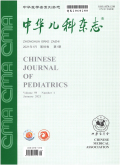中国10个省、自治区、直辖市学龄前儿童铁缺乏的流行病学调查研究
Epidemiological investigation of iron deficiency among preschool children in 10 provinces, autonomous regions, or municipalities in China
摘要目的:了解我国学龄前儿童贫血、铁缺乏和缺铁性贫血的现况。方法:横断面研究,采用多阶段分层抽样法选取我国10个省、自治区、直辖市(东部地区江苏、浙江、山东、海南,中部地区河南,西部地区重庆、陕西、贵州、新疆,东北地区辽宁)的150个街道或乡镇。2022年5月至2023年4月调查接受儿童保健服务的散居儿童(0.5~<3.0岁)和幼儿园的集居儿童(3.0~<7.0岁)共21 470名,按年龄分为3组(0.5~<1.0岁为婴儿组、1.0~<3.0岁为幼儿组、3.0~<7.0岁为学龄前组)。调查儿童性别、出生日期等基本信息,采集末梢血检测血常规和血清铁蛋白。分析儿童贫血、铁缺乏及缺铁性贫血率,采用 χ2检验比较不同年龄、性别、城市与农村、地区间的患病率差异。 结果:有效调查人数21 460名,其中男10 780名(50.2%);婴儿、幼儿、学龄前组分别为2 645名(12.3%)、6 244 名(29.1%)、12 571名(58.6%);血红蛋白(126.7±14.8)g/L,血清铁蛋白32.3(18.5,50.1)μg/L;总贫血率、铁缺乏率、缺铁性贫血率分别为10.4%(2 230/21 460)、28.3%(6 070/21 460)、3.9%(845/21 460)。男童贫血率高于女童[10.9%(1 173/10 780)比9.9%(1 057/10 680), χ2=5.58, P=0.018];婴儿、幼儿、学龄前组儿童的贫血率差异有统计学意义[18.0%(475/2 645)、10.6%(662/6 244)、8.7%(1 093/12 571), χ2=201.81, P<0.01];农村儿童贫血率高于城市[11.8%(1 516/12 883)比8.3%(714/8 577), χ2=65.54, P<0.01];各地区贫血率差异有统计学意义( χ2=126.60, P<0.01),其中中部地区儿童贫血率最高,为15.8%(343/2 173),东北地区最低,为5.3%(108/2 053)。婴儿、幼儿、学龄前组铁缺乏率分别为33.8%(895/2 645)、32.2%(2 011/6 244)、25.2%(3 164/12 571),男、女童铁缺乏率分别为30.0%(3 229/10 780)、26.6%(2 841/10 680),东部、中部、西部、东北地区铁缺乏率分别为21.7%(1 913/8 821)、40.0%(870/2 173)、27.1%(2 283/8 413)、48.9%(1 004/2 053),差异均有统计学意义( χ2=147.71、29.73、773.02,均 P<0.01)。城市和农村儿童缺铁性贫血率差异有统计学意义[2.9%(251/8 577)比4.6%(594/12 883), χ2=38.62, P<0.01],铁缺乏率差异并无统计学意义( χ2=0.51, P=0.476)。 结论:我国学龄前儿童的铁缺乏及缺铁性贫血已有明显改善,但现状仍不容忽视,应重视铁缺乏及缺铁性贫血的防控,尤其是婴幼儿和中部、西部及东北地区的儿童。
更多相关知识
abstractsObjective:To understand the current status of anemia, iron deficiency, and iron-deficiency anemia among preschool children in China.Methods:A cross-sectional study was conducted with a multi-stage stratified sampling method to select 150 streets or townships from 10 Chinese provinces, autonomous regions, or municipalities (East: Jiangsu, Zhejiang, Shandong, and Hainan; Central: Henan; West: Chongqing, Shaanxi, Guizhou, and Xinjiang; Northeast: Liaoning). From May 2022 to April 2023, a total of 21 470 children, including community-based children aged 0.5 to<3.0 years receiving child health care and kindergarten-based children aged 3.0 to<7.0 years, were surveyed. They were divided into 3 age groups: infants (0.5 to<1.0 year), toddlers (1.0 to<3.0 years), and preschoolers (3.0 to<7.0 years). Basic information such as sex and date of birth of the children was collected, and peripheral blood samples were obtained for routine blood tests and serum ferritin measurement. The prevalence rates of anemia, iron deficiency, and iron-deficiency anemia were analyzed, and the prevalence rate differences were compared among different ages, sex, urban and rural areas, and regions using the chi-square test.Results:A total of 21 460 valid responses were collected, including 10 780 boys (50.2%). The number of infants, toddlers, and preschoolers were 2 645 (12.3%), 6 244 (29.1%), and 12 571 (58.6%), respectively. The hemoglobin level was (126.7±14.8) g/L, and the serum ferritin level was 32.3 (18.5, 50.1) μg/L. The overall rates of anemia, iron deficiency, and iron-deficiency anemia were 10.4% (2 230/21 460), 28.3% (6 070/21 460), and 3.9% (845/21 460), respectively. The prevalence rate of anemia was higher for boys than for girls (10.9% (1 173/10 780) vs. 9.9% (1 057/10 680), χ2=5.58, P=0.018), with statistically significant differences in the rates for infants, toddlers and preschoolers (18.0% (475/2 645), 10.6% (662/6 244), and 8.7% (1 093/12 571), respectively, χ2=201.81, P<0.01), and the rate was significantly higher for children in rural than that in urban area (11.8% (1 516/12 883) vs. 8.3% (714/8 577), χ2=65.54, P<0.01), with statistically significant differences in the rates by region ( χ2=126.60, P<0.01), with the highest rate of 15.8% (343/2 173) for children in Central region, and the lowest rate of 5.3% (108/2 053) in Northeastern region. The prevalence rates of iron deficiency were 33.8% (895/2 645), 32.2% (2 011/6 244), and 25.2% (3 164/12 571) in infants, toddlers, and preschoolers, respectively, and 30.0% (3 229/10 780) in boys vs. 26.6% (2 841/10 680) in girls, 21.7% (1 913/8 821), 40.0% (870/2 173), 27.1% (2 283/8 413), 48.9% (1 004/2 053) in Eastern, Central, Western, and Northeastern regions, respectively, and each between-group showed a significant statistical difference ( χ2=147.71, 29.73, 773.02, all P<0.01). The prevalence rate of iron-deficiency anemia showed a significant statistical difference between urban and rural areas, 2.9% (251/8 577) vs. 4.6% (594/12 883) ( χ2=38.62, P<0.01), while the difference in iron deficiency prevalence was not significant ( χ2=0.51, P=0.476). Conclusions:There has been a notable improvement in iron deficiency and iron-deficiency anemia among preschool children in China, but the situation remains concerning. Particular attention should be paid to the prevention and control of iron deficiency and iron-deficiency anemia, especially among infants and children in the Central, Western, and Northeastern regions of China.
More相关知识
- 浏览171
- 被引0
- 下载6


相似文献
- 中文期刊
- 外文期刊
- 学位论文
- 会议论文



 换一批
换一批 换一批
换一批



